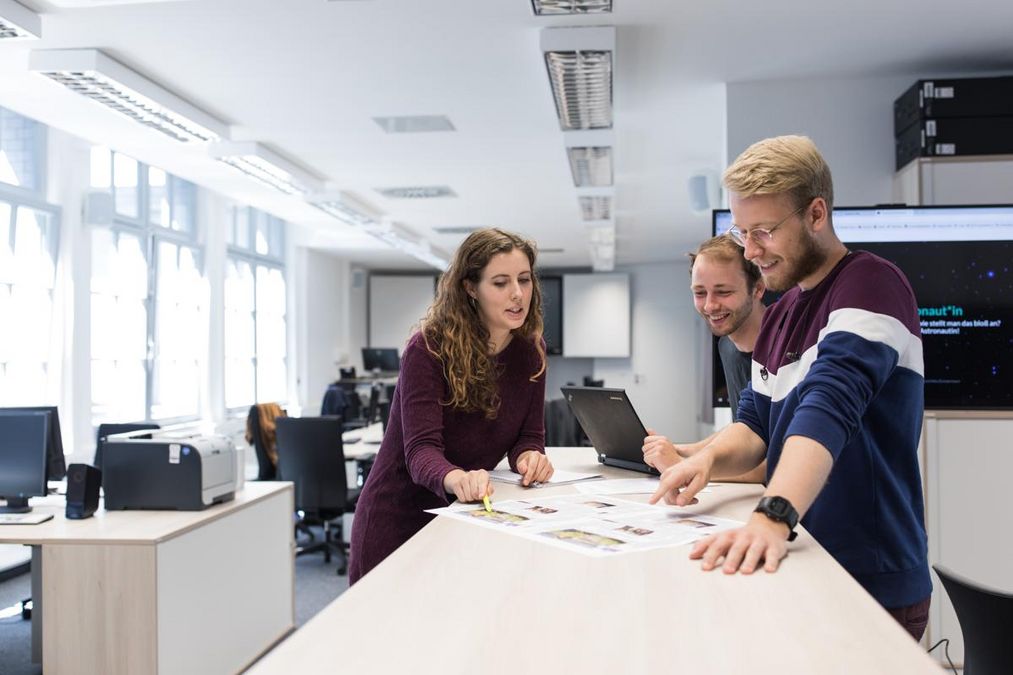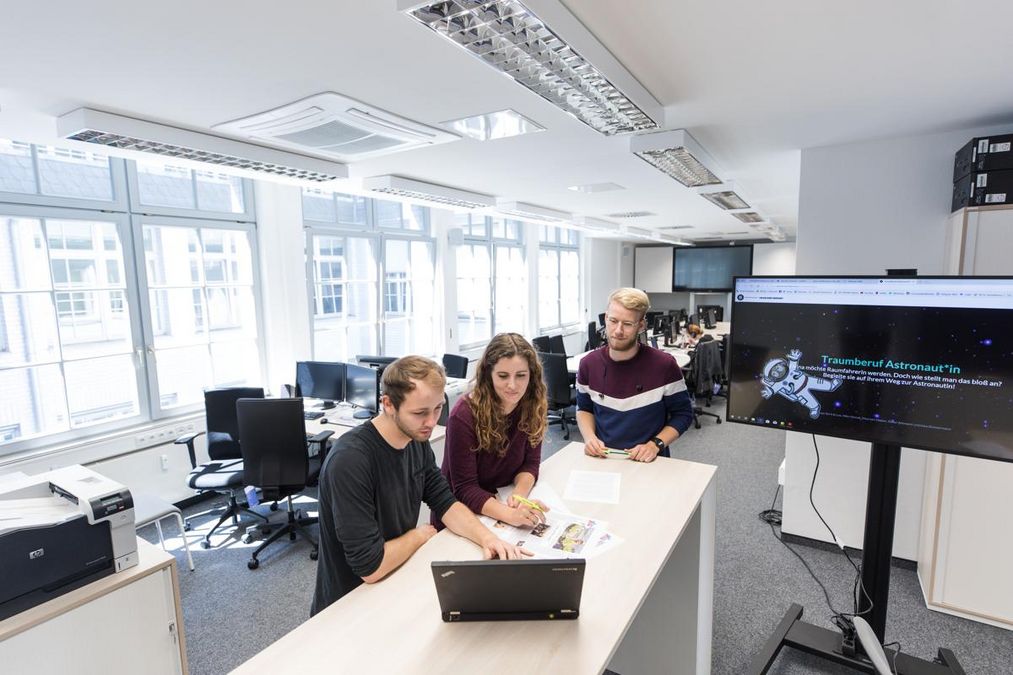For teaching and research, the professorship for journalism research has a 108 square meter cross-media teaching editorial office with newsdesk and production islands as well as the journalism research laboratory. The teaching editorial office and laboratory are the spatial centerpiece of the M.Sc. Journalism program, in which mainly the program’s project seminars take place. The teaching editorship can also be used freely by journalism students outside of class hours.
The journalism teaching department at the Professorship for Journalism Research is a modern newsroom in which contemporary cross-media journalistic work for print, online, audio, video and social media is possible. This is where the application-related, project-oriented courses of the master’s degree in journalism and the “LVZ-Campus” teaching editorial office in the bachelor’s elective subject cross-media journalism take place. Journalism students can freely use the teaching editorial office for study purposes such as project and group work.
Furthermore, the teaching editorial office also serves as a research location, since editorial processes can be realistically simulated here. The premises are supplemented by the journalism research laboratory, which is used in particular for research purposes and for innovation projects in the master's degree in journalism.
Prof. Dr. Markus Beiler designed the teaching editorial office and the journalism research laboratory as part of his focus on the science-led further development of university-bound journalism training and applied empirical journalism research and introduced it in the Winter Semester 2015/16 in the premises of the Institute for Communication and Media Studies.
Teaching Editorial Office
For the development of the cross-media teaching editorial concept and the newsroom, newsroom concepts in practice, education and academia were fundamentally revised in a one-year research project. The study was carried out on cross-media newsroom concepts at German newspaper publishers, who were recorded quantitatively and structurally via telephone interviews and qualitatively on the basis of guided discussion. The work organization and the effects with those responsible were then analyzed.*)
As part of the move of the Institute for Communication and Media Studies from the Thüringer Hof (Burgstraße 21) to the Zeppelinhaus (Nikolaistraße 27-29) in February/March 2019, Prof. Dr. Markus Beiler further developed the teaching editorial office and the journalism research laboratory conceptually and technically. The teaching editorial office and the laboratory were adapted to the requirements of the fundamentally reformed master’s degree in journalism that started in the 2018/19 winter semester. The premises have been in operation since the summer semester of 2019.
*) Reference: Beiler, M. & Gerstner, J. (2019). Newsroom- und Newsdeskstrukturen zur Reduzierung von Binnenkomplexität im crossmedialen Journalismus. Quantitativ-qualitative Mehrmethodenstudie zur Struktur und Bewertung der Redaktionsform bei den deutschen Tageszeitungen. In B. Dernbach, A. Sehl & A. Godulla (Hrsg.), Reduktion vom Komplexität im und durch Journalismus (S. 91-99). Wiesbaden: Springer VS.
The 108m² teaching editorial office is located on the third floor of the Zeppelinhaus along the inner courtyard of the former tobacco merchant house built in 1911/12 and is L-shaped. The editorial office has two entrances. Students usually enter the teaching editorial office through the front entrance, located in the north wing by the main staircase. Most of the offices of the journalism teaching and research branch are located behind the back entrance (north wing of the building). The teaching editorial office is air-conditioned and secured with an alarm.
The long, 61m² part of the L contains a 7m long and 1.60m-wide newsdesk as well as two separate production islands at the rear end. The short, 47m² part of the L contains a meeting table with 12 seats. The long and short parts of the L-shaped room are divided by a standing conference table with around 12 seats. The main entrance is also located here. Due to these different facilities, different editorial settings and meeting situations are possible.
The central newsdesk is equipped with a total of nine computers and up to 20 workstations, so that there is room for an entire year of the master's program in journalism. One of the computers is located at the top of the newsdesk, called the beam. Lecturers or student managing editors, for example, find their place here.
There are four computers on each of the two long sides of the newsdesk: on the side of the newsdesk facing the window front of the inner courtyard, a computer workstation for student editors and a workstation with a multimedia computer with two 24-inch WUXGA screens and keyboards are attached to a beam where layout and video/audio editing is possible. Apart from the multimedia computer, all computer workstations at the newsdesk are equipped with normal workstation computers for research and production tasks. If necessary, two students can work as a team on a computer at each workstation.
Next to the beam, there is a motorized, height-adjustable table for presentations with another computer with a touch display (lecturer's spot). On the other side of the beam is the rear entrance to the teaching editorial office.
The two separate production islands in the direction of the main entrance to the teaching editorial office each have a multimedia computer that is equipped identically to the one at the news desk (also with two monitors), and each has another normal workstation computer. The two production islands are designed for teams of up to four people.
On production island 1, there is a DIN A3 color laser printer, e.g. for the output of proofs for the campus page of the Leipziger Volkszeitung, which is produced in the teaching editorial office of the bachelor's elective subject cross-media journalism. There are two A4 laser printers on production island 2, one in color and one in black and white for normal printouts.
Since the further development of the teaching editorial office, modern media technology has been available: behind the top of the newsdesk, or the beam, there is an 86-inch interactive 4K display for presentation purposes (HDMI/VGA connections). In addition, a mobile 55-inch amplification monitor can be moved in the teaching editorial office and e.g. mirrored presentations for the area of the production islands or the meeting corner.
Sound is output through four speakers. The media technology is controlled via the lecturer's seat and a media rack with a Blueray player. There is also a 60-inch HD television for presentations (HDMI/VGA connections) in the meeting corner. There are also six telephones in the teaching editorial office.
The teaching staff has its own two semi-professional HD video cameras, two digital single-lens reflex cameras and two digital audio recording devices and tripods. These can be borrowed by the students, as well as various laptops for mobile work. Further digital production technology for the special needs of the master's program in journalism is still being acquired.
In addition, production technology is available at the Center for Technology and Communication at the University of Leipzig (ZMK). DIRECTLY TO THE ZMK.
The application-related, project-oriented courses for the master’s degree in journalism and the “LVZ-Campus” teaching editorial in the bachelor’s elective subject of cross-media journalism take place in the teaching editing department. Journalism students can freely use the teaching editing for study purposes such as project and group work.
Teaching editorial office and laboratory are the spatial centerpiece of the M.Sc. Journalism program, in which the project seminars mainly take place. The teaching editorship can also be used freely by students of the master's degree in journalism and the "Campus" course in the bachelor's elective subject cross-media journalism outside of course times.
Tip: The computer pool in the institute building (room 2.16) can also be used freely during opening hours. Journalistic software is also available on the iMacs (including Adobe Creative Suite Design Standard with Photoshop and Indesign, Adobe Premiere Pro on selected computers, FinalCut Pro X, DigaSystem). More information about the computer pool.
Authorized students can open (and close) the front door of the teaching editorial office with a PIN code during the general opening hours of the institute or have it unlocked by the secretary’s office (room 3.12). The entrance to the building can be opened immediately with the UniCard.
Upon signature, authorized students can borrow a transponder from the secretary’s office for a maximum of four calendar days, which also allows access outside the opening hours of the institute around the clock. There are currently five transponders available: two transponders each for the 1st/2nd or 3rd/4th Semester of the master's degree in journalism and a transponder for the bachelor's elective subject cross-media journalism. An extension is possible if other students have not already registered. The transponder must be presented to the secretary’s office for the extension.
The teaching editorship is also a central research location - in two senses: Firstly, cross-media editorial processes can be simulated and researched under laboratory conditions and at the same time realistically. Secondly, innovation and research project seminars for the master’s degree in journalism also take place in the teaching editorial department.
The teaching editing can also be used in the context of the preparation of master’s theses and doctorates in the research field of applied empirical journalism research. Scientific findings generated here can in turn flow into transfer projects in journalistic practice and training and further education.
Furthermore, an accompanying evaluation of the teaching editors on the basis of academic methods serves the goal of a permanent optimization of the structure and work opportunities of the teaching editorial office.
Laboratory Journalism Research
Together with the teaching editors, Prof. Dr. Markus Beiler designed the journalism research laboratory. Both institutions are necessarily closely linked and complement each other in an application-oriented university master’s degree. Established for the first time in the 2014/15 winter semester, the journalism research laboratory in the new institute building was thoroughly developed for the 2019 summer semester.
The laboratory serves experimental journalism research in particular. Editorial processes, in particular conference situations like editorial meetings, can be simulated and observed here. Innovation and research project seminars for the master’s degree in journalism also take place here. Students can only use the laboratory freely in exceptional cases and only with reference to courses (e.g. for telephone conferences during project work).
The 36m² journalism research laboratory is located on the third floor of the Zeppelinhaus (south wing of the building) in the inner courtyard opposite the teaching editorial office. Students access the front entrance via the south wing of the Zeppelinhaus. Most of the offices of the journalism teaching and research area are located behind the back entrance (north wing of the building).
The laboratory has a large conference table with at least 12 seats and two computer workstations (one with two monitors) at desks that are height-adjustable by electric motors. A 65-inch 4K television (HDMI connection) is available for presentation purposes. A conference phone can be used at the meeting table.

